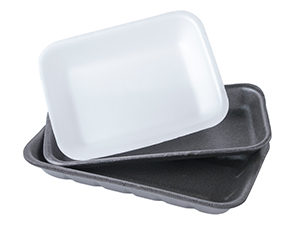
What’s wrong with Styrofoam aka Polystyrene?
Environmental Issues of Polystyrene
Polystyrene, more commonly known as Styrofoam, is often the material of choice for many meat, poultry, seafood, and produce processors; although this material is widely used, it poses substantial threats to both human health and the environment as a whole.
500 Years to Decompose
Large quantities of polystyrene are used every day and are often disposed of in household trash bins and make their way to landfills.
By volume, the amount of space used up in landfills by all plastics is between 25 and 30%, according to Foundation for Advancements in Science and Education in Los Angeles, California.
This is an issue because of Styrofoam’s inability to quickly breakdown; in fact, Styrofoam takes approximately 500 years to break down — and even greater lengths of time if buried (like in a landfill).
Marine Pollution
Further issues are created from the lack of ability for Styrofoam to decompose.
Due to its light nature and fragility, Styrofoam can often blow away from refuse disposal centers and enter public drain systems or exposed waterways and end up in the ocean.
During the material’s journey, it can break into smaller pieces and be consumed by marine life, which may cause harm or potentially kill.
It also hard to contain and collect in the ocean and may have negative impacts on the tourist industry if not addressed quickly enough.
The United Nations Environment Program estimated in 2006 that every square mile of ocean hosts 46,000 pieces of floating plastic.
Human Health Concerns
There are substantial human health concerns when discussing polystyrene (Styrofoam).
It has been shown to cause cancer in animals; however, this has not necessarily been shown to be true in humans.
Polystyrene does show negative impacts on human health in different ways.
Styrene primarily exhibits its toxicity to humans as a neurotoxin by attacking the central and peripheral nervous systems.
The accumulation of these highly lipid-soluble (fat-soluble) materials in the lipid-rich tissues of the brain, spinal cord, and peripheral nerves is correlated with acute or chronic functional impairment of the nervous system.
Can You Recycle Polystyrene?
The answer is “maybe.”
Technically, polystyrene can be recycled in certain areas, but its efficiency as far as reusing the material is limited.
In many cases, it poses substantial food safety concerns because of a difficult sterilization process and is often labor intensive.
These limiting factors have led to a reduction in polystyrene recycling facilities, making the issue of polystyrene in landfills an even greater concern.
What Are the Alternatives to Foam?
Click here to learn more about the different eco-friendly packaging options and which is best for your application.
Click here to view our eco-friendly food packaging products.



